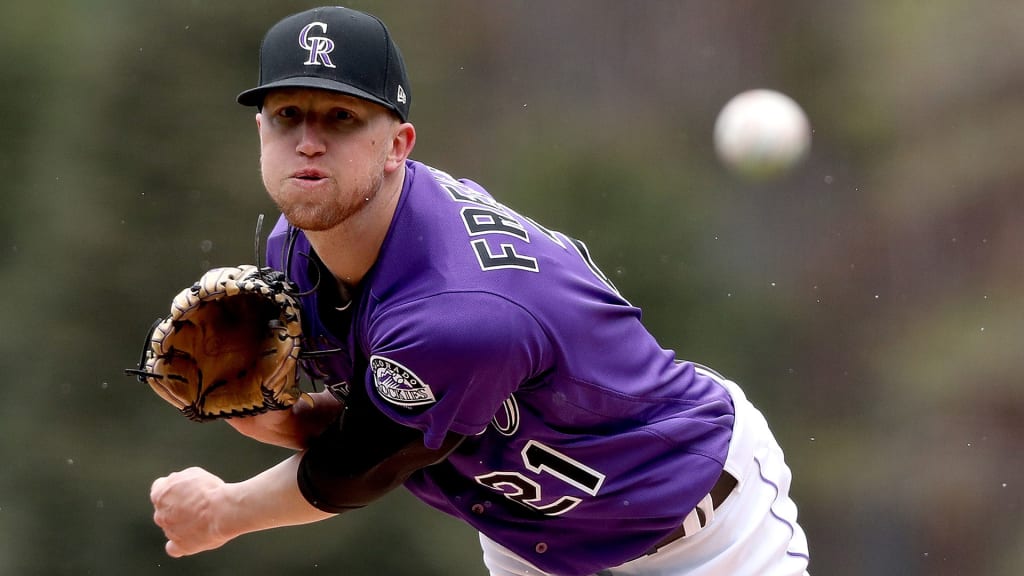
DENVER -- If Rockies left-hander Kyle Freeland returns from last month’s left groin strain -- which looks more likely after his 50-pitch simulated game Tuesday -- he plans to pitch without the voices that rang in his head when his season spiraled into a mess.
Pitching was simpler last year, when Freeland went 17-7 with a 2.85 ERA and finished fourth in National League Cy Young Award voting.
“I was like, that’s exactly who I am -- four-pitch mix, hitting locations, being very fine with everything and getting weak contact,” Freeland said. “Then this year, things just went sideways. It was very humbling.”
Then it became confusing. Last year, just an in-game gesture or word from veteran catcher Chris Iannetta did the trick. But this year, when that wasn’t enough, Freeland listened to a myriad of coaches and advisers and lost himself.
But Freeland believes the poor numbers (3-11, 6.98 ERA in 20 Major League starts), the six-week send-down to Triple-A Albuquerque and even all the well-meaning pointers that nonetheless pushed him further into the pitching wilderness are beginning to pay off.
Even with some mixed results before Freeland left an Aug. 20 start against the D-backs, he reported that “everything felt right.”
If he returns for one or two outings, it’s doubtful he’ll pitch more than three innings in a game. But he’ll look at whatever action he sees as a building block for 2020.
Here are five keys for his return to success:
1. Filtered listening
Before his option to Albuquerque on May 31, Freeland was all ears. He took suggestions to tinker with the pace of his delivery and his arm angle.
“I strayed away from what I knew and what I felt comfortable with,” Freeland said. “I tried a lot of new things trying to see if it would fit and click and work.
“Then there was a lot of information, a lot of people talking to me, plus me getting in my own head and maybe not looking at myself as a whole and saying, ‘What is right for me?’”
2. Make a list, check it often
It’s not that Freeland will plug his ears. But he has developed a system for knowing what to do with the information.
“I’m able to filter down what I know works,” he said. “I have my stuff written down, my keys that if I ever get into a struggling situation after a start, I can go back and read that and know these are my keys I need to check off.
“Iannetta helped me out a lot with it. He let me know when my front side was low, he let me know when to get my arm up. Those are visual keys he’d give me in game situations, and then we’d talk about it postgame when we’d watch video. Now when he’s gone, it’s more on me to make sure I’m doing those things. I have those things written down. I can go back to them whenever.”
3. No hesitation ...
Since breaking in with the Rockies in 2017, Freeland has gone back and forth between pausing, either at the top of his leg lift (this year) or the Clayton Kershaw-esque pause during his kick toward home plate (earlier in his career).
The current method is a small bounce at the top of his leg kick. Gone is the notable pause from a delivery that at times looked as if he was posing for the bobblehead the club distributed in early August.
“That way I’m not coming to a full stop and starting up again,” Freeland said. “Last year, the success I had with the pause was because I was so in tune with my mechanics and was on time with it that it worked out. But now creating that rhythm to have everything working smoothly is what it formed into, and it feels good. It’s nothing new.”
4. … unless he needs it
If all is right with the rest of his delivery, the pause could become an unexpected twist.
“It could be something where I have a long at-bat with a couple hitters and we’re in the 7-8-pitch range, then we could throw that pause in to get them off my timing,” Freeland said. “It can still be used as a weapon and a training tool.”
5. No regrets
Last winter, after his breakout performance last season, Freeland was contemplating a change -- using his changeup (never a big pitch for him) -- to get the ball arm side (outside to right-handers, inside to lefties).
And when things went bad, Freeland tried to swing with the coaching advice.
It didn’t work, but Freeland isn’t the type to waste emotion on regret.
“I wouldn’t say I regret any of it,” he said. “Looking back on it now, it was more of a learning experience, knowing what works for me and what doesn’t work for me. It sucks the way things panned out with the season that I had, but now I know what adjustments I need to make and what adjustments to stay away from because I know those don’t fit me.”
Updates
• As expected, righty German Marquez (12-5, 4.76 ERA in 28 starts) will not pitch again this season. But he is playing catch, and says the right arm inflammation that forced him to the 10-day injured list last month has healed.
• Freeland was generally effective during the simulated game. But right-handed-hitting Pat Valaika powered a hanging curve into the left-field bleachers, then gave Freeland a chuckle.
Valaika stepped out of the batter's box and quipped that the homer was payback for Freeland forcing him to foul a ball off his left foot earlier in the session.
